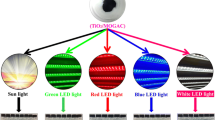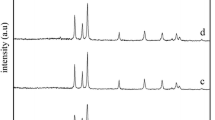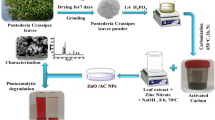Abstract
The elimination of phosphates and nitrates in contaminated water is a challenging environmental issue, especially in a large-scale context. Therefore, the aim of this work is the fabrication of zinc oxide (ZnO)/Moringa oleifera gum activated carbon (MOGAC) nanocomposites constructed by the sol–gel method and applied to the photocatalytic removal of PO43− and NO3− in aqueous solutions under different light irradiations. The phase composition and morphology of the MOGAC, ZnO NPs, and ZnO/MOGAC NCs were characterized using XRD, FT-IR, FESEM-EDS, UV–Vis-DRS, and BET analyzer. The FESEM image of MOGAC reveals the micro- and mesopores on its surface, which resembles a honeycomb voids-like structure. The bandgap energy values of the ZnO and ZnO/MOGAC NCs were 3.2 eV and 3.4 eV, respectively, which were corresponding to the reflectance wavelength of 420 nm. The surface range of ZnO/MOGAC NCs resolute was recorded as 172.71 m2/g. The removal performance of the ZnO/MOGAC NCs in various pH, catalyst dose, contact times, and varying substrate ion concentrations was assessed. The removal experimental results exposed that the red LED spectrum and 10 mg of ZnO/MOGAC NCs removed PO43− and NO3− ions to 95% after 105 and 90 min of irradiation, respectively. Also, the ZnO/MOGAC NCs sustained good stability after four cycles of PO43− and NO3− removal.
Graphical abstract










Similar content being viewed by others
Data availability
Not applicable.
References
Hui C, Guo X, Sun P, Khan RA, Zhang Q, Liang Y, Zhao YH (2018) Removal of nitrite from aqueous solution by Bacillus amyloliquefaciensbiofilm adsorption. Bioresour Technol 248:146–152
Li R, Wang JJ, Zhou B, Zhang Z, Liu S, Lei S, Xiao R (2017) Simultaneous capture removal of phosphate, ammonium and organic substances by MgO impregnated biochar and its potential use in swine wastewater treatment. J Clean Prod 147:96–107
Zhang L, Wan L, Chang N, Liu J, Duan C, Zhou Q, Li X, Wang X (2011) Removal of phosphate from water by activated carbon fiber loaded with lanthanum oxide. J Hazard Mater 190:848–855
Shi W, Fu Y, Jiang W, Ye Y, Kang J, Liu D, Ren Y, Li D, Luo C, Xu Z (2019) Enhanced phosphate removal by zeolite loaded with Mg–Al–La ternary (hydr) oxides from aqueous solutions: Performance and mechanism. Chem Eng J 357:33–44
Stayner LT, Almberg K, Jones R, Graber J, Pedersen M, Turyk M (2017) Atrazine and nitrate in drinking water and the risk of preterm delivery and low birth weight in four Midwestern states. Environ Res 152:294–303
Espejo-Herrera N, Cantor KP, Malats N, Silverman DT, Tardón A, García-Closas R, Serra C, Kogevinas M, Villanueva CM (2015) Nitrate in drinking water and bladder cancer risk in spain. Environ Res 137:299–307
Wu Y, Wang Y, Wang J, Xu S, Yu L, Philippe C, Wintgens T (2016) Nitrate removal from water by new polymeric adsorbent modified with amino and quaternaryammonium groups: Batch and column adsorption study. J Taiwan Inst Chem Eng 66:191–199
Song H, Yao Z, Shuang C, Li A (2014) Accelerated removal of nitrate from aqueous solution by utilizing polyacrylic anion exchange resin with magnetic separation performance. J Ind Eng Chem 20:2888–2894
Yang W, Shi X, Wang J, Chen W, Zhang L, Zhang W, Zhang X, Lu J (2019) Fabrication of a Novel Bifunctional Nanocomposite with Improved Selectivity for Simultaneous Nitrate and Phosphate Removal from Water. ACS Appl Mater Interfaces 11:35277–35285
Li B, Boiarkina I, Yu W, Huang HM, Munir T, Wang GQ, Young BR (2019) Phosphorous recovery through struvite crystallization: Challenges for future design. Sci Total Environ 648:1244–1256
Guo M, Feng L, Liu Y, Zhang L (2020) Electrochemical simultaneous denitrification and removal of phosphorus from the effluent of a municipal wastewater treatment plant using cheap metal electrodes. Environ Sci Water Res Technol 6:1095–1105
Liu S, Liu JW, Wang H, Yang YX, Liu ST, Hanigan D, Zhao HZ (2020) New Antifouling and Antibacterial Membrane Material for Highly Selective Removal of Nitrate and Phosphate. Ind Eng Chem Res 59:12114–12122
An Y, Zhou Z, Qiao W, Pan W, Chen Z (2017) Simultaneous removal of phosphorus and dissolved organic matter from a sludge: In situ reduction process effluent by coagulants. RSC Adv 7:42305–42311
Volpin F, Chekli L, Phuntsho S, Cho J, Ghaffour N, Vrouwenvelder JS, Kyong Shon H (2018) Simultaneous phosphorous and nitrogen recovery from source-separated urine: A novel application for fertilizer drawn forward osmosis. Chemosphere. 203:482–489
DjouadiBelkada F, Kitous O, Drouiche N, Aoudj S, Bouchelaghem O, Abdi N, Grib H, Mameri N (2018) Electrodialysis for fluoride and nitrate removal from synthesized photovoltaic industry wastewater. Sep Purif Technol 204:108–115
Karanasios KA, Vasiliadou IA, Pavlou S, Vayenas DV (2010) Hydrogenotrophic denitrification of potable water: A review. J Hazard Mater 180:20–37
Loganathan P, Vigneswaran S, Kandasamy J (2013) Enhanced removal of nitrate from water using surface modification of adsorbents - A review. J Environ Manag 131:363–374
Liu R, Chi L, Wang X, Sui Y, Wang Y, Arandiyan H (2018) Review of metal (hydr) oxide and other adsorptive materials for phosphate removal from water. J Environ Chem Eng 6:5269–5286
Gupta VK, Moradi O, Tyagi I, Agarwal S, Sadegh H, Shahryari-Ghoshekandi R, Makhlouf ASH, Goodarzi M, Garshasbi A (2016) Study on the removal of heavy metal ions from industry waste by carbon nanotubes: Effect of the surface modification: A review. Crit Rev Environ Sci Technol 46:93–118
Xiong B, Piechowicz B, Wang Z, Marinaro R, Clement E, Carlin T, Uliana A, Kumar M, Velegol SB (2018) Moringa oleifera f-sand filters for sustainable water purification. Environ Sci Tech Lett 5:38–42
Uphadek B, Shinkar DM, Patil PB, Saudagar RB (2018) Moringa oleifera as a pharmaceutical excipient. Int J Curr Pharm Res 10:13–16
Tian Q, Wu W, Sun L, Yang S, Lei M, Zhou J, Liu Y, Xiao X, Ren F, Jiang C, Roy VA (2014) Tube-like ternary α-Fe2O3@SnO2@ Cu2O sandwich heterostructures: synthesis and enhanced photocatalytic properties. ACS Appl Mater Interfaces 6:13088–13097
Mao N (2019) Investigating the Heteronjunction between ZnO/Fe2O3 and gC3N4 for an Enhanced Photocatalytic H2 production under visible-light irradiation. Sci Rep 9:1–9
Le Van K, Luong Thi Thu T (2019) Preparation of Pore-Size Controllable Activated Carbon from Rice Husk Using Dual Activating Agent and Its Application in Supercapacitor. J Chem 2019:1–11. https://doi.org/10.1155/2019/4329609
Velu M, Balasubramanian B, Velmurugan P, Kamyab H, Ravi AV, Chelliapan S, Lee CT, Palaniyappan J (2021) Fabrication of nanocomposites mediated from aluminium nanoparticles/Moringa oleifera gum activated carbon for effective photocatalytic removal of nitrate and phosphate in aqueous solution. J Clean Prod 281:124553
Priyadharsan A, Shanavas S, Vasanthakumar V, Balamuralikrishnan B, Anbarasan PM (2018) Synthesis and investigation on synergetic effect of rGO-ZnO decorated MoS2 microflowers with enhanced photocatalytic and antibacterial activity. Colloids Surf A Physicochem Eng Asp 559:43–53
Kurosaki F, Ishimaru K, Hata T, Bronsveld P, Kobayashi E, Imamura Y (2003) Microstructure of wood charcoal prepared by flash heating. Carbon N Y 41:3057–3062
Fageria P, Gangopadhyay S, Pande S (2014) Synthesis of ZnO/Au and ZnO/Ag nanoparticles and their photocatalytic application using UV and visible light. RSC Adv 4:24962–24972
Seid L, Lakhdari D, Berkani M, Belgherbi O, Chouder D, Vasseghian Y, Lakhdari N (2022) High-efficiency electrochemical degradation of phenol in aqueous solutions using Ni-PPy and Cu-PPy composite materials. J Hazard Mater 423:126986
Berkani M, Smaali A, Kadmi Y, Almomani F, Vasseghian Y, Lakhdari N, Alyane M (2022) Photocatalytic degradation of Penicillin G in aqueous solutions: Kinetic, degradation pathway, and microbioassays assessment. J HazardMater 421:126719
Begum S, Ahmaruzzaman M (2018) Biogenic synthesis of SnO2/activated carbon nanocomposite and its application as photocatalyst in the degradation of naproxen. Appl Surf Sci 449:780–789
Das B, Khan MI, Jayabalan R, Behera SK, Il Yun S, Tripathy SK, Mishra A (2016) Understanding the Antifungal Mechanism of Ag@ZnO Core-shell Nanocomposites against Candida krusei. Sci Rep 6:1–12
Tan IAW, Ahmad AL, Hameed BH (2008) Adsorption of basic dye using activated carbon prepared from oil palm shell: batch and fixed bed studies. Desalination 225:13–28
Gupta VK, Rastogi A (2009) Biosorption of hexavalent chromium by raw and acid-treated green alga Oedogoniumhatei from aqueous solutions. J Hazard Mater 163:396–402
Muniandy L, Adam F, Mohamed AR, Ng EP (2014) The synthesis and characterization of high purity mixed microporous/mesoporous activated carbon from rice husk using chemical activation with NaOH and KOH. Microporous Mesoporous Mater 197:316–323
Ji Y, Li T, Zhu L, Wang X, Lin Q (2007) Preparation of activated carbons by microwave heating KOH activation. Appl Surf Sci 254:506–512
Ceyhan AA, Şahin Ö, Baytar O, Saka C (2013) Surface and porous characterization of activated carbon prepared from pyrolysis of biomass by two-stage procedure at low activation temperature and it’st head sorption of iodine. J Anal Appl Pyrolysis 104:378–383
Yang J, Qiu K (2010) Preparation of activated carbons from walnut shells via vacuum chemical activation and their application for methylene blue removal. Chem Eng J 165:209–217
Sivachidambaram M, Vijaya JJ, Kennedy LJ, Jothiramalingam R, Al-Lohedan HA, Munusamy MA, Elanthamilan E, Merlin JP (2017) Preparation and characterization of activated carbon derived from the: Borassusflabellifer flower as an electrode material for supercapacitor applications. New J Chem 41:3939–3949
Osman H, Su Z, Ma X, Liu S, Liu X, Abduwayit D (2016) Synthesis of ZnO/C nanocomposites with enhanced visible light photocatalytic activity. Ceram Int 42:10237–10241
Jayarambabu N, Rao KV, Prabhu YT (2015) beneficial role of zinc oxide nanoparticles ON green crop production. Int J Multidiscip Adv Res Trends 2:273–282
Bindu P, Thomas S (2014) Estimation of lattice strain in ZnO nanoparticles: X-ray peak profile analysis. J Theor Appl Phys 8:123–134
Kansal SK, Lamba R, Mehta SK, Umar A (2013) Photocatalytic degradation of Alizarin Red S using simply synthesized ZnO nanoparticles. Mater Lett 106:385–389
Rajesh N, Kannan JC, Krishnakumar T, Leonardi SG, Neri G (2014) Sensing behavior to ethanol of tin oxide nanoparticles prepared by microwave synthesis with different irradiation time. Sensors Actuators B Chem 194:96–104
Hosseini SA, Babaei S (2017) Graphene oxide/zinc oxide (GO/ZnO) nanocomposite as a superior photocatalyst for degradation of methylene blue (MB)-process modeling by response surface methodology (RSM). J Braz Chem Soc 28:299–307
Ganesh Kumar A, Swarnalatha S, Kamatchi P, Kirubagaran R, Perinmbam K, Sekaran G (2009) Immobilization of proteolytic enzyme on highly porous activated carbon derived from rice bran. J Porous Mater 16:439–445
Chen R, Li L, Liu Z, Lu M, Wang C, Li H, Ma W, Wang S (2017) Preparation and characterization of activated carbons from tobacco stem by chemical activation. J Air Waste Manag Assoc 67:713–724
Rajendiran K, Soumiya D, SudaroliSudha J (2014) Allelopathy and cytotoxicity of aqueous extracts of Lantana camaraL. on Zea mays L. Var. Cauvery. JFAV 4:165–171
Sharififard H, Pepe F, Soleimani M, Aprea P, Caputo D (2016) Iron-activated carbon nanocomposite: Synthesis, characterization and application for lead removal from aqueous solution. RSC Adv 6:42845–42853
Zhang P, Chen Y, Yang X, Gui J, Li Y, Peng H, Liu D, Qiu J (2017) Pt/ZnO@C Nanocable with Dual-Enhanced Photocatalytic Performance and Superior Photostability. Langmuir 33:4452–4460
Chandraboss VL, Kamalakkannan J, Prabha S, Senthilvelan S (2015) An efficient removal of methyl violet from aqueous solution by an AC-Bi/ZnO nanocomposite material. RSC Adv 5:25857–25869
Shanavas S, Priyadharsan A, Vasanthakumar V, Arunkumar A, Anbarasan PM, Bharathkumar S (2017) Mechanistic investigation of visible light driven novel La2CuO4/CeO2/rGO ternary hybrid nanocomposites for enhanced photocatalytic performance and antibacterial activity. J Photochem Photobiol A Chem 340:96–108
Huang H, Liu L, Zhang Y, Tian N (2014) Novel BiIO4/BiVO4 composite photocatalyst with highly improved visible-light-induced photocatalytic performance for rhodamine B degradation and photocurrent generation. RSC Adv 5:1161–1167
Chen Q, Shi H, Shi W, Xu Y, Wu D (2012) Enhanced visible photocatalytic activity of titania-silica photocatalysts: Effect of carbon and silver doping. Catal Sci Technol 2:1213–1220
Mahyar A, Behnajady MA, Modirshahla N (2010) Characterization and photocatalytic activity of SiO2-TiO2 mixed oxide nanoparticles prepared by sol-gel method. Indian J Chem 49:1593–1600
Liu J, Khan U, Coleman J, Fernandez B, Rodriguez P, Naher S, Brabazon D (2016) Graphene oxide and graphene nanosheet reinforced aluminium matrix composites: Powder synthesis and prepared composite characteristics. Mater Des 94:87–94
Inyang M, Gao B, Zimmerman A, Zhang M, Chen H (2014) Synthesis, characterization, and dye sorption ability of carbon nanotube-biochar nanocomposites. Chem Eng J 236:39–46
Balu S, Uma K, Pan GT, Yang TCK, Ramaraj SK (2018) Degradation of methylene blue dyeinthepresenceofvisiblelightusingSiO2@α-Fe2O3 nanocomposites depositedon SnS2 flowers. Materials 11:1030
Ahmed Y, Yaakob Z, Akhtar P (2016) Degradation and mineralization of methylene blue using a heterogeneous photo-Fenton catalyst under visible and solar light irradiation. Catal Sci Technol 6:1222–1232
Aljeboree AM, Alshirifi AN, Alkaim AF (2017) Kinetics and equilibrium study for the adsorption of textile dyes on coconut shell activated carbon. Arab J Chem 10:S3381–S3393
Long M, Brame J, Qin F, Bao J, Li Q, Alvarez PJJ (2017) Phosphate Changes Effect of Humic Acids on TiO2 Photocatalysis: From Inhibition to Mitigation of Electron-Hole Recombination. Environ Sci Technol 51:514–521
Xia S, Xu X, Xu C, Wang H, Zhang X, Liu G (2016) Preparation, characterization, and phosphate removal and recovery of magnetic MnFe2O4nano-particles as adsorbents. Environ Technol 37:795–804
Abazari R, Mahjoub AR (2018) Amine-Functionalized Al-MOF#@yxSm2O3-ZnO: A Visible Light-Driven Nanocomposite with Excellent Photocatalytic Activity for the Photo- Degradation of Amoxicillin. Inorg Chem 57:2529–2545
El Ouardi M, Qourzal S, Alahiane S, Assabbane A, Douch J (2015) Effective Removal of Nitrates Ions from Aqueous Solution Using New Clay as Potential Low-Cost Adsorbent. J Encapsulation Adsorpt Sci 05:178–190
Kong JZ, Zhai HF, Zhang W, Wang SS, Zhao XR, Li M, Li H, Li AD, Wu D (2017) Visible Light-Driven Photocatalytic Performance of N-DopedZnO/g-C3N4 Nanocomposites. Nanoscale Res Lett 12:1–10
Zolfaghari G, Esmaili-Sari A, Anbia M, Younesi H, Ghasemian MB (2013) A zinc oxide-coated nanoporous carbon adsorbent for lead removal from water: Optimization, equilibrium modeling, and kinetics studies. Int J Environ Sci Technol 10:325–340
Li W, Wang G, Chen C, Liao J, Li Z (2017) Enhanced visible light photocatalytic activity of Zno nanowires doped with Mn2+ and Co2+ ions. Nanomaterials 7:1–11
Gangu KK, Maddila S, Jonnalagadda SB (2019) A review on novel composites of MWCNTs mediated semiconducting materials as photocatalysts in water treatment. Sci Total Environ 646:1398–1412
Wang X, Wang F, Sang Y, Liu H (2017) Full-spectrum solar-light-activated photocatalysts for light–chemical energy conversion. Adv Energy Mater 7:1–15
Farag HK, Aboelenin RM, Fathy NA (2017) Photodegradation of methyl orange dye by ZnO loaded onto carbon xerogels composites. Asia Pac J Chem Eng 12:4–12
Huang Y, Chen D, Hu X, Qian Y, Li D (2018) Preparation of TiO2/carbon nanotubes/reduced graphene oxide composites with enhanced photocatalytic activity for the degradation of rhodamine B. Nanomaterials 8:1–9
Kalaruban M, Loganathan P, Shim WG, Kandasamy J, Ngo HH, Vigneswaran S (2016) Enhanced removal of nitrate from water using amine-grafted agricultural wastes. Sci Total Environ 565:503–510
Mohan N, Vijayalakshmi KP, Koga N, Suresh CH (2010) Comparison of aromatic NHπ, OHπ, and CHπ interactions of alanine using MP2, CCSD, and DFT methods. J Comput Chem 31:2874–3288
Berkani M, Vasseghian Y, Dragoi EN, Khaneghah AM (2021) The Fenton-like reaction for Arsenic removal from groundwater: Health risk assessment. Environ Res 202:111698
Doan VD, Huynh BA, Le Pham HA, Vasseghian Y (2021) Cu2O/Fe3O4/MIL-101 (Fe) nanocomposite as a highly efficient and recyclable visible-light-driven catalyst for degradation of ciprofloxacin. Environ Res 201:111593
Vasseghian Y, Almomani F, Moradi M, Dragoi EN (2022) Decontamination of toxic Malathion pesticide in aqueous solutions by Fenton-based processes: Degradation pathway, toxicity assessment and health risk assessment. J Hazard Mater 423:127016
Nguyen THA, Nguyen VC, Phan TNH, Vasseghian Y, Trubitsyn MA, Nguyen AT, Chau TP, Doan VD (2022) Novel biogenic silver and gold nanoparticles for multifunctional applications: Green synthesis, catalytic and antibacterial activity, and colorimetric detection of Fe (III) ions. Chemosphere 287:132271
Shah N, Bhangaonkar K, Pinjari DV, Mhaske ST (2017) Ultrasound and Conventional Synthesis of Ceo2/Zno Nanocomposites and Their Application in the Photocatalytic Degradation of Rhodamine B Dye. J Adv Nanomater 2:133–145
Su Y, Yang W, Sun W, Li Q, Shang JK (2015) Synthesis of mesoporous cerium-zirconium binary oxide nanoadsorbents by a solvothermal process and their effective adsorption of phosphate from water. Chem Eng J 268:270–279
Lei Y, Huo J, Liao H (2017) Microstructure and photocatalytic properties of polyimide/heterostructured NiO-Fe2O3-ZnO nanocomposite films via an ion-exchange technique. RSC Adv 7:40621–40631
Yu X, Li Z, Dang K, Zhang Z, Gao L, Duan L, Jiang Z, Fan J, Zhao P (2018) Enhanced photocatalytic activity of Ag–ZnO/RGO nanocomposites for removal of methyleneblue. J Mater Sci Mater Electron 29:8729–8737
Ravichandran K, Nithiyadevi K, Sakthivel B, Arun T, Sindhuja E, Muruganandam G (2016) Synthesis of ZnO:Co/rGO nanocomposites for enhanced photocatalytic and antibacterial activities. Ceram Int 42:17539–17550
Acknowledgements
This research was funded by University Grants Commission-Rajiv Gandhi National Fellowship Programme (Sanction Number: F1-17.1/2016–17/RGNF-2015–17-SC-TAM-1534) for their financial support. The authors also are thankful to the Department of Environmental Science, Periyar University, Salem, Tamil Nadu-636 011, India, for providing all the required facilities in relation to this research work. Also, authors thank Taif University Researchers, supporting project number TURSP-2020/91, Taif University, Taif, Saudi Arabia. Finally, this study also is thankful to Malaysia-Japan International Institute of Technology, Universiti Teknologi Malaysia and South Ural State University for extending support for research collaboration as visiting senior researcher.
Author information
Authors and Affiliations
Contributions
Conceptualization: V.M., H.K., B.Ba., P.J; Writing manuscript draft: V.M., B.Ba.; Formal analysis and Methodology: B.B.,V.M., D.E; Data Curation: V.M., P.V., B.Bh., P.J; Data validation and interpretation: P.V., R.B., S.C., H.K.,; Writing: Review and Editing: H.K.,M.H.A., S.C., P.V., R.B.; Supervision: P.J., P.V. All Authors revised and approved the final article.
Corresponding authors
Ethics declarations
Ethics approval
Not applicable.
Consent to participate
Not applicable.
Consent for publication
Not applicable.
Competing interests
The authors declare no competing interests.
Additional information
Publisher's note
Springer Nature remains neutral with regard to jurisdictional claims in published maps and institutional affiliations.
Balamuralikrishnan Balasubramanian is equal contributor as the first author.
Highlights
• Pure ZnO NPs and ZnO/MOGAC NCs were fabricated by the sol–gel method
• 95% of PO43− and NO3− ions were removed by ZnO/MOGAC NCs via red LED irradiation
• Post-treated ZnO/MOGAC NCs revealed considerable morphological changes
• 80% of PO43- and NO3- ions removal from domestic wastewater by ZnO/MOGAC NCs
Supplementary Information
Below is the link to the electronic supplementary material.
Rights and permissions
About this article
Cite this article
Manikandan, V., Balasubramanian, B., Bharti, B. et al. Development of ZnO/MOGAC nanocomposites for enhanced photocatalytic removal of PO43− and NO3- ions from wastewater under various light irradiations. Biomass Conv. Bioref. (2022). https://doi.org/10.1007/s13399-021-02173-7
Received:
Revised:
Accepted:
Published:
DOI: https://doi.org/10.1007/s13399-021-02173-7




